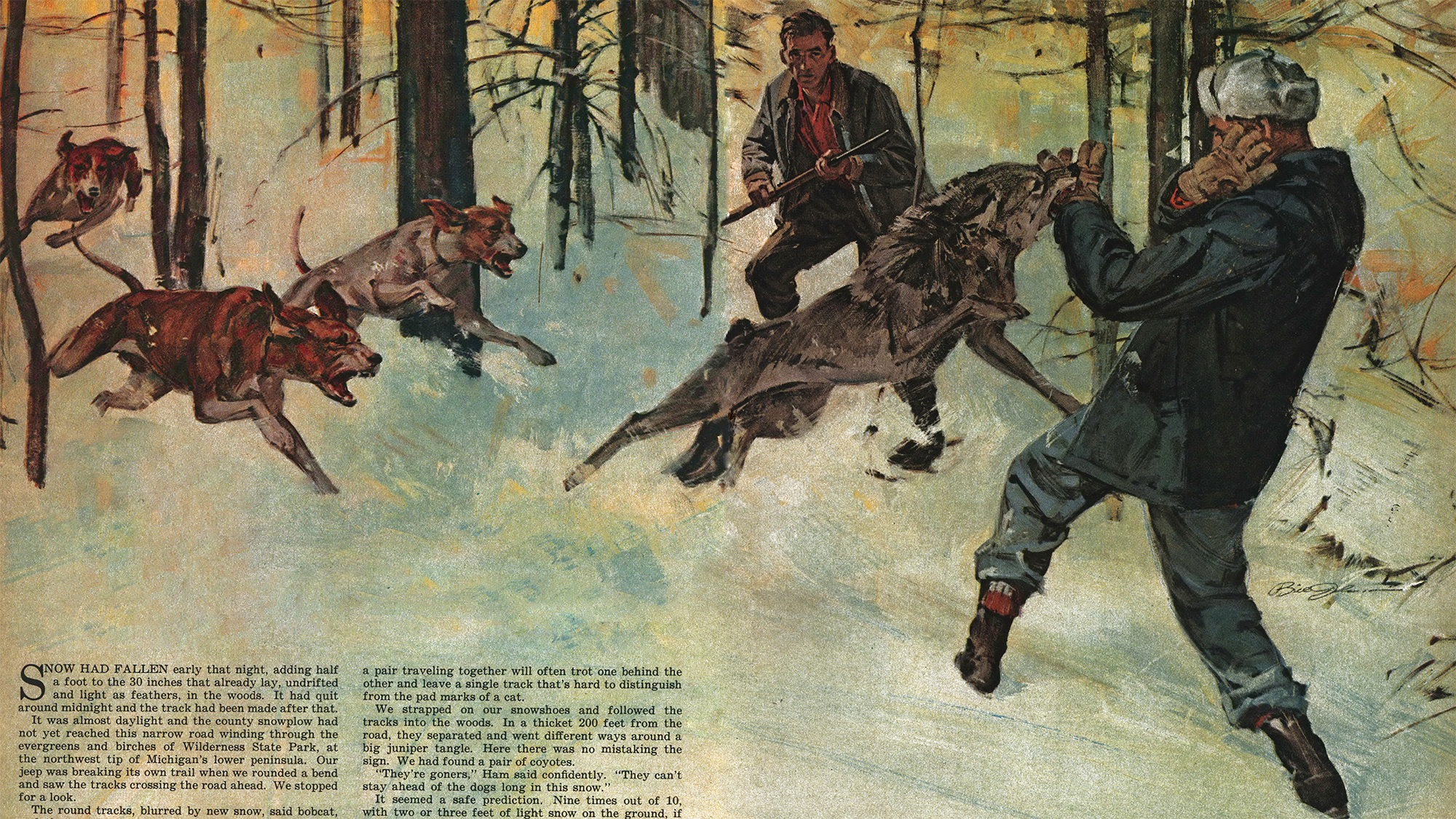This story, “For Men Only,” originally ran in the November 1962 issue of Outdoor Life.
SNOW HAD FALLEN early that night, adding half a foot to the 30 inches that already lay, undrifted and light as feathers, in the woods. It had quit around midnight and the track had been made after that. It was almost daylight and the county snowplow had not yet reached this narrow road winding through the evergreens and birches of Wilderness State Park, at the northwest tip of Michigan’s lower peninsula. Our jeep was breaking its own trail when we rounded a bend and saw the tracks crossing the road ahead. We stopped for a look.
The round tracks, blurred by new snow, said bobcat, and that was not what we were looking for. But the longer Roy Vincent, Ham Sheveline, and I studied them, the more likely it seemed that they had been made by two coyotes trotting in each other’s steps, and that was what we were looking for. It was mid-January, with mating season coming on, and while that lasts a pair traveling together will often trot one behind the other and leave a single track that’s hard to distinguish from the pad marks of a cat.
We strapped on our snowshoes and followed the tracks into the woods. In a thicket 200 feet from the road, they separated and went different ways around a big juniper tangle. Here there was no mistaking the sign. We had found a pair of coyotes.
“They’re goners,” Ham said confidently. “They can’t stay ahead of the dogs long in this snow.
It seemed a safe prediction. Nine times out of 10, with two or three feet of light snow on the ground, if we strike a track we kill the coyote in short order. We’d no reason to think today was going to be any different. By the time the hunt ended, long after dark, Roy and I were too tired to twit Ham about famous last words. Ham, a fur buyer from Central Lake, is a hound man with good dogs and he has an abiding interest in bear, bobcat, and coyote hunting.
We went back to the road and unloaded his snow-sled from its trailer, found a spot to park the jeep, hooked a homemade sled carrying two dog boxes behind the snow sled, put Ring and Baldy in the boxes, and took the track.
We picked our way through open timber, skirting juniper taller than a man’s head, and in less than half a mile the two coyotes crossed the beach of Big Stone Bay and took to the open ice. Here the wind had scoured most of the snow away and running conditions were perfect. We took Ring and Baldy out of their boxes and let them go.
They lined out across the ice, parallel to shore, running west toward Waugoshance Point and Crane Island a mile beyond, bawling a lively duet. Ham gunned the snow-sled and we flew along after them.
The sleds we use are ideal vehicles for winter woods travel. Powered with a 9 1/2-horsepower air-cooled engine and capable of making close to 35 miles an hour, they’re mounted on a pair of ski-like runners in front for steering and two fixed runners at the rear. The drive belt is a caterpillar-tread device of heavy rubber with steel cleats, floating between the rear runners and loose at the back end, so it can chew its way down into the snow to firm footing. Powerful enough to carry two or three men, the sled can be driven anywhere the timber will let it through. Vincent and I own one between us, in addition to Ham’s, and they’ve saved us many miles of snowshoeing.
We were close behind the dogs when, at the end of a two-mile run, they turned in to the beach and went out of sight in a thick stand of cedar. Minutes later, when we killed the engine to listen, they were half a mile away to the west, bawling full blast. We knew one of the coyotes was running ahead of them.
We dropped the tow sled and circled to find out what had happened. Jumped in the cedar tangles, the two coyotes had separated, the male heading for Crane Island, the smaller female swinging south toward Sturgeon Bay and then cutting back into the park. Our hounds were driving the dog.
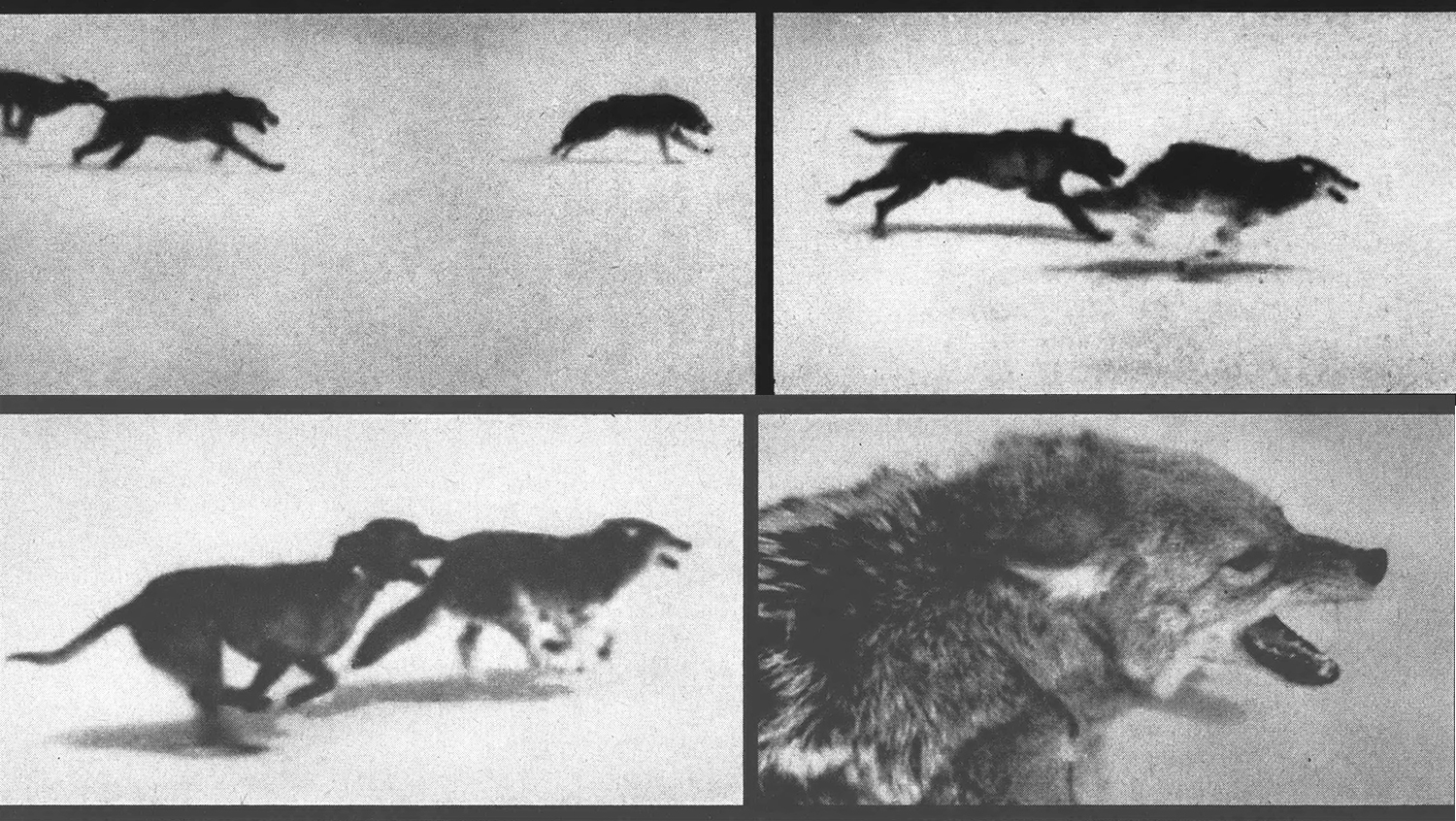
That coyote had been hunted before and knew what it was all about. Unless things got too tough, he preferred the timber of Crane Island to the open ice of Lake Michigan. The island is about a mile across and he made one complete circuit. But Ring and Baldy had a big advantage. He was breaking trail for them, and on the last lap they crowded him too hard. He turned out on the ice, toward the upper peninsula shore 20 miles away, and poured on coal. When we arrived at the place where the tracks left the beach we could see our two hounds, no bigger than specks a couple of miles out, but the coyote was out of sight.
We debated what to do, but not for long. We didn’t like what we were tackling, for however solidly the north end of Lake Michigan may freeze, it’s a huge, windswept place and the ice fields are never still for long. Wind and currents shift and move them, breaking off floes a mile across, separating them with big open cracks, crunching them back together, grinding them up, piling up ridges as tall as a man. In one windless night, the whole white landscape may freeze into a compact mass with patches of clear new ice where there was open water at dusk. But once the wind stirs the floes at daybreak, the process of breaking, moving, and grinding begins all over again.
From where we faced the treacherous field, on the beach of Crane Island, the nearest upper peninsula shore loomed 10 miles away to the northeast. To the northwest, the way the coyote and our dogs were going, however, it was twice that far.
But, in the back of our minds, all three of us were thinking the same thing. No hound man worth his salt deserts his dogs, and we didn’t intend to desert ours. Vincent spoke for all of us when he said, “Well, I guess the only way we’ll find out what the ice is like out there is to go and see.”
The ice was about as we expected. There were old floes, smooth and covered with snow, some half a mile across. There were veins of new ice, frozen within the past two days, thick enough to hold us but no more. There were rough places that had ground together and the cold had cemented them in jagged masses that we had to detour around. Worst of all, there were long cracks of open water. Some were only a foot or so across and the sled slid over them without any risk, but others were five or six feet wide. Those we had to follow until we came to a place where the currents had pushed the ice back together.
Occasionally, on a patch of hard snow, we picked up the tracks of the coyote and our two hounds, running a zigzag course. There was no sign that the dogs were gaining, and we were making poor time ourselves.
It was close to noon when we ran our sled up on the beach of a timbered bluff between the towns of Brevort and Epoufette. I’ll confess that when I felt dry land under the runners I took my first deep breath in three hours.
The dogs and coyote had gone up the bluff, and we had a good idea what had happened. A major highway, U.S. 2, ran east and west up there, a mile inland. The coyote was headed for it and would run on the bare pavement until cars scared him off. Now we had to worry about the chance of our dogs being killed by a car.
I got into my snowshoes and started up the bluff. Roy and Ham would wait on the beach until I reported back. The coyote had run straight for the highway. The tracks on the plowed shoulder showed that he and the dogs had swung east, toward St. Ignace. But I knew that even a tired coyote has too great an aversion for cars to stay long on such a road, and I was sure that when he left it he would turn back toward Lake Michigan and Wilderness Park. Like all animals driven by dogs, sooner or later a coyote heads for home. He may run over 30 miles—this one had already covered 25—but in the end he circles back to where he was jumped.
I went back to the sled and we drove out on the ice where the going was better and turned east. We’d gone a couple of miles when we saw dog and coyote tracks leading down across the beach. It was two hours past noon and our wolf was going home, but he was tired enough to prefer the open ice and in no hurry to get back to Crane Island. It lay due south. He led the dogs southwest, out across the almost limitless ice. Out there, beyond our sight, lay Hog and Garden islands. We began to wonder whether he was going to include them in the huge circle he was running.
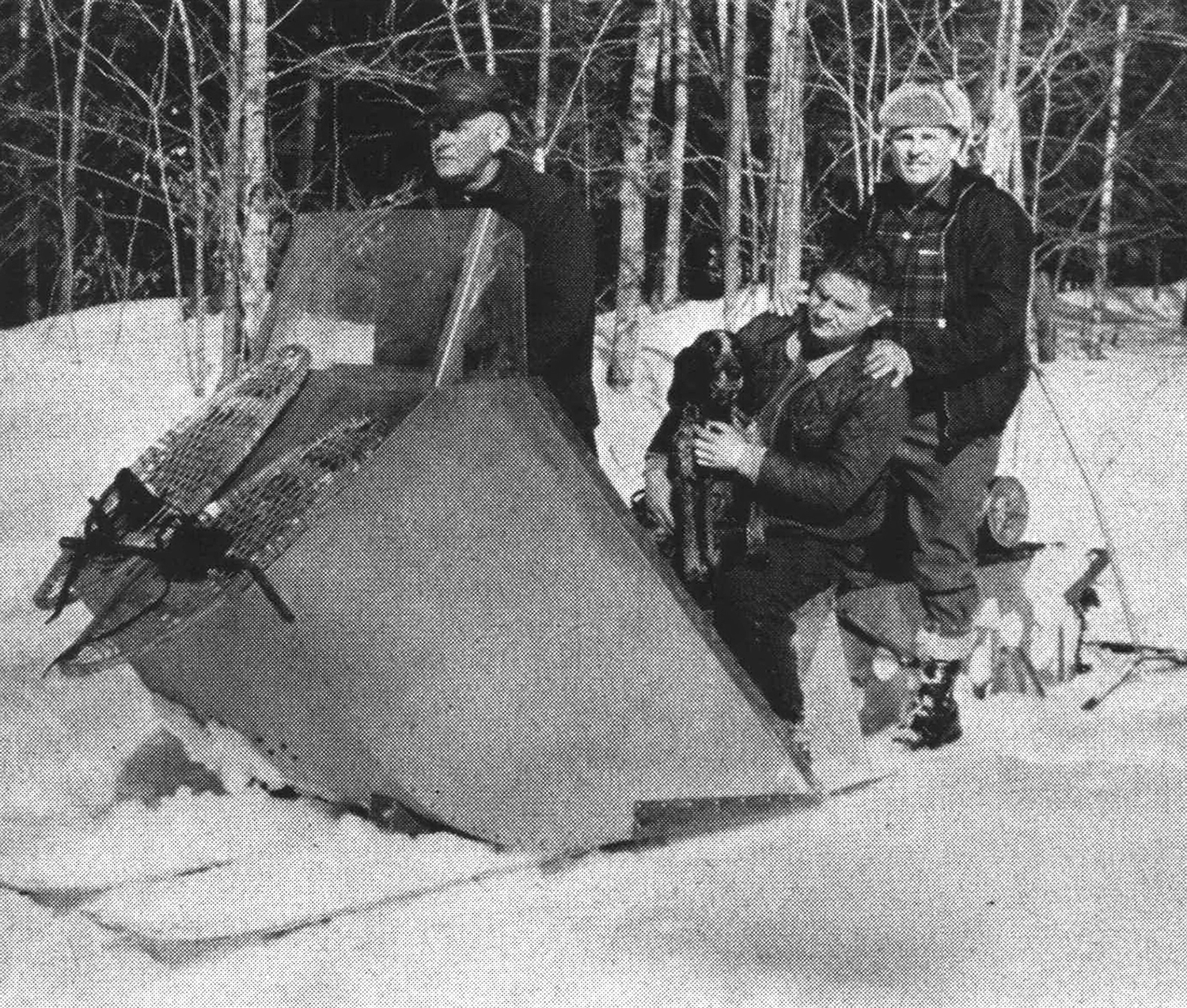
Our return trip across the ice was a repeat performance of the forenoon crossing, complete with rough fields and open cracks. We had no choice but to follow the tracks of the dogs as they angled back and forth behind the coyote. We knew they were too tired to overtake him unless they cornered him in deep snow on an island, and if they kept their course it would be dark before that happened. Even if we lost them, we’d have to get off the ice while there was still daylight.
We were about 10 miles offshore when we saw something moving slowly ahead of us. It was Ring, still on the track but going at a walk, letting out a weary bawl of defiance every few steps. We caught up and took him aboard.
At dusk, on open ice to the southwest of Crane Island, we picked up Baldy. There was just enough light left in the sky to enable us to watch for cracks when we got ashore. We reached the jeep at 10 o’clock. Calculating by gas consumption alone, we had made 60 miles on the sled. We’ll never know where that coyote finally went.
“I’m not surprised at the two of you,” Ham said thoughtfully while we were loading the sled, “but I am kind of surprised at myself. I thought I had better sense.”
YOU MIGHT logically ask how a man in his right mind gets mixed up with a sport as rugged as this is. Well, in my case, my dad and grandpappy lived to hunt fox and coon in southern Ohio where I was born and grew up. I cut my milk teeth playing around with hound dogs, and the older I grew the more I enjoyed ’em. In 1946, the health of the older of our two daughters made it necessary for us to move from Dayton to Indian River, where I now work as a plasterer. Indian River is an attractive little town between Burt and Mullet lakes, 25 miles south of Mackinaw City. Knowing nothing about the area I was moving to, I sold my dogs before I left Ohio.
I hadn’t been in my new location long before I found out I’d made a big mistake. The country around Indian River was not only prime for fox and coon, but it also had deer, grouse, bears, bobcats and, most important of all, coyotes. I naturally teamed up with Vincent, a service station operator in Indian River who kept good hounds and had been using them on the little wolves for years. We killed 10 or 12 the first winter, and I knew I had found the answer to a hound man’s prayers. For fast action and excitement, coyotes were miles ahead of anything I’d ever run with dogs.
Success calls for three things: an abundance of quarry, good dogs, and the ability to follow them. Luckily we have all three. We hunt a big triangle, stretching 75 miles from Lake Michigan on the west to Lake Huron on the east, and 35 miles north and south, from Wolverine to the Straits of Mackinac. It’s timbered country, cut over in the logging days, and has big lakes, streams, swamps, and hills. Coyotes are plentiful. Roy and I have taken 15 to 18 a winter for the past 15 years. None have come easy, but they’ve all been worth it. We collect the Michigan bounty of $15 for males, $20 for females, but taking into account the cost of acquiring and keeping our dogs, veterinary fees, and all, we invest a lot more than that in every one we kill.
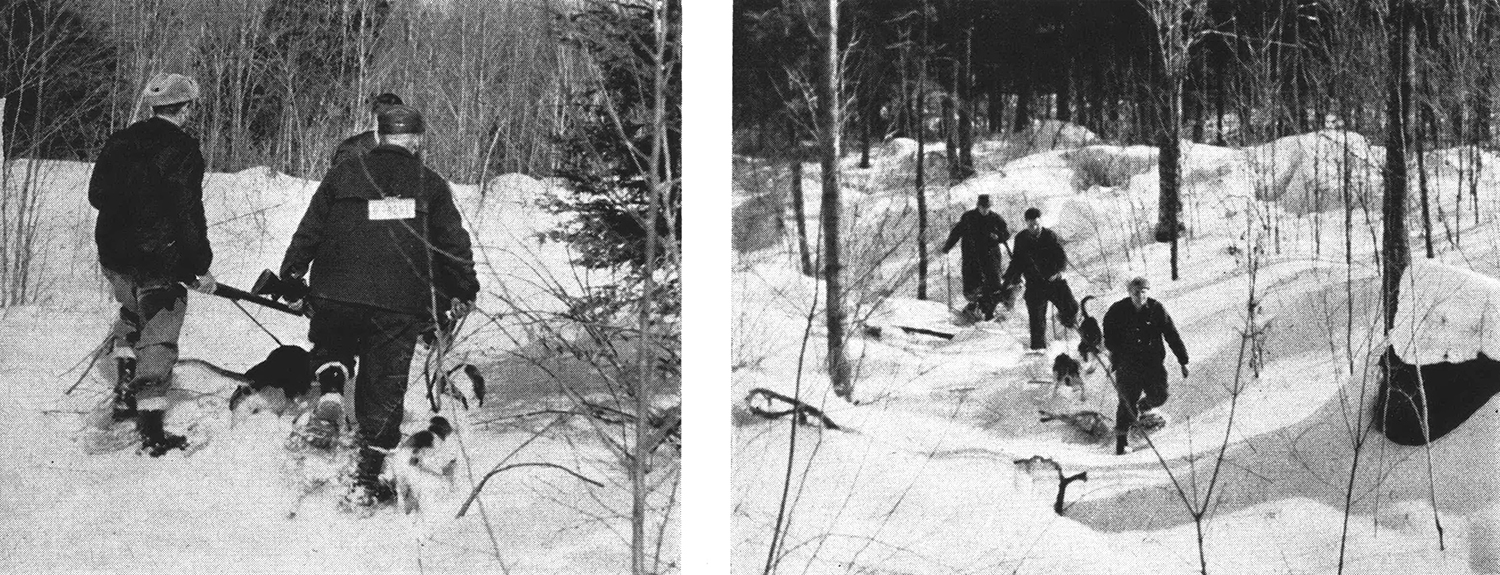
THOUGH WE HUNT from the end of deer season until the snow goes off in late March or early April, the best time is from mid-January to late February. Snow conditions are right then and the coyotes, driven by the urge to mate, move more and travel farther. Fresh tracks are easy to find.
A coyote has everything that makes the red fox a prime favorite ahead of hounds, but he has more of it. He’s bigger, bolder, and tougher. His nose is as keen as a deer’s, his ears as good, and he has eyes in the back of his head. Though he ranges far, traveling 25 to 30 miles in a night when food is scarce, he knows the location of every swamp, lake, stream, deer yard, beaver pond, and windfall in it. He’s full of tricks and not likely to make mistakes.
He’ll go into a deer yard and circle among the deer, or he’ll run out on slick ice where he leaves little scent. The dogs that chase him must be big, long-legged hounds with good feet and plenty of speed and staying power. They also have to be fighters on land or in water, for a driven coyote will cross big rivers and if cornered near water is likely to swim out to a log or island or take refuge on a half-submerged fallen tree. Dogs that won’t follow can’t finish the job.
We have eight in our pack now, Bruiser, Screamer, Machine Gun, Alvin, Jack, Baldy, Ranger, and Ring, all July hounds. Three are top cold-trailers, two are killers, all are heel burners. Of the coyotes we take, the dogs catch and kill about two out of three. The others we shoot ahead of them by figuring out crossing places and using the jeep or snow sled to get there first. On most of our hunts I use a 12 gauge Winchester Model 12, bored for Magnum shells, and Roy carries a Remington .270 with a Weaver K-4 scope. We’re ready for almost anything that comes along, either long shots or close up in brush.
On two or three feet of snow our hounds often catch and kill in 20 to 30 minutes, but when the snow is only a few inches deep the coyote may stay ahead of them for hours and sometimes they can’t catch him at all.
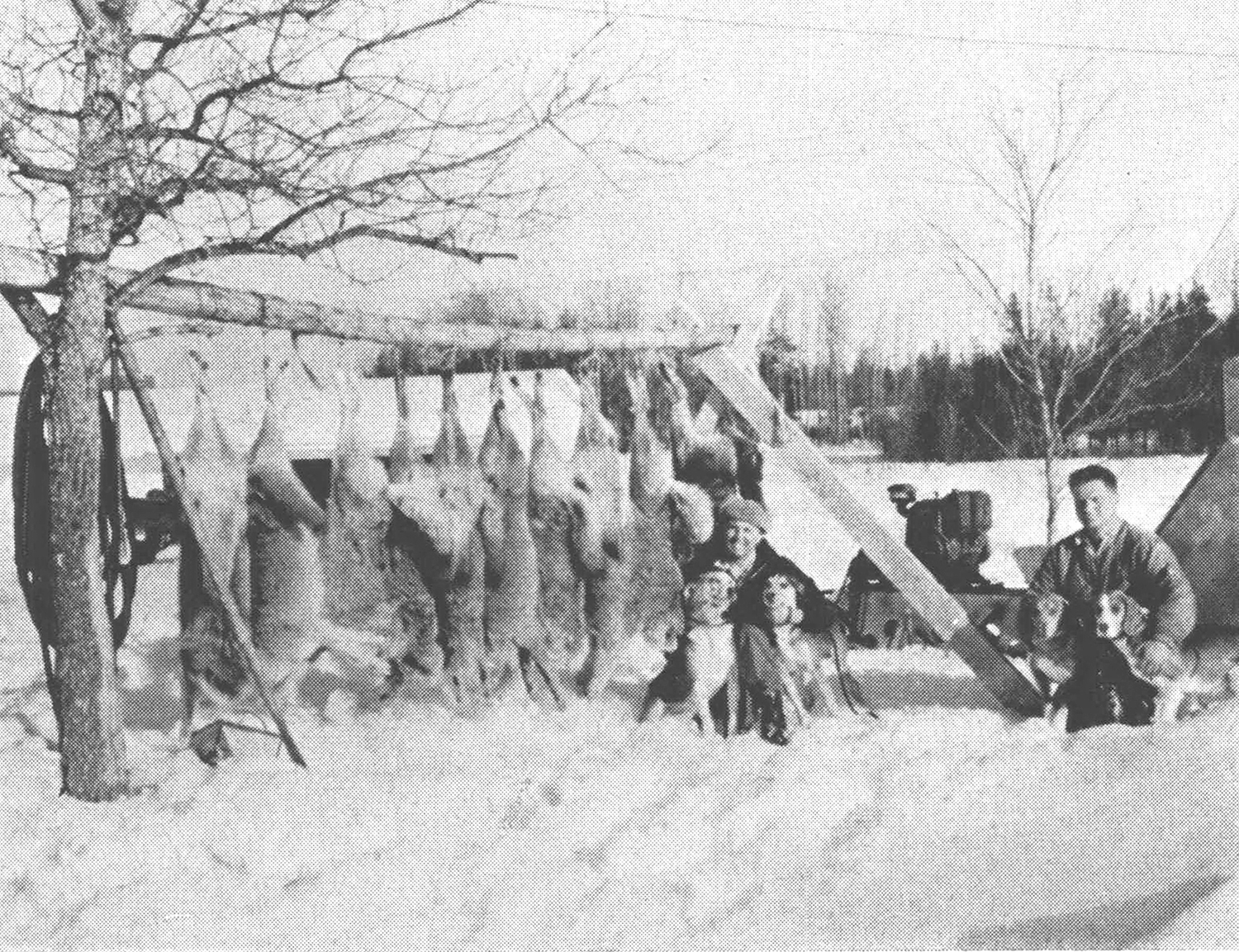
IT ISN’T ACTUALLY necessary for the dogs to do the killing, but they must have the grit to fight and hold any coyote they overtake, worrying him enough so that he will not break bay and run again when the hunters come up. Reaching a weight of 30 to 35 pounds (we’ve taken males up to 38), the coyote is a wicked character in a scrap, with wolf ways and wolf guts, and few hounds can kill him single-handed. Even when three or four dogs bring him to bay, they’re likely to hang back, each waiting for the others to make the first pass. For that reason, you have to have one or two in the pack with enough sand to dive in and get things going. The rest will follow as soon as the fight starts.
With us, Ring or Bruiser lead the way. Ring is a tough, burly hound that rushes in, hits with a shoulder and knocks the coyote off its feet, grabs it by the throat, and hangs on. Bruiser prefers a chest hold, but either will kill any coyote he can get at.
If the wolf has a chance to back under a windfall or a hollow log, where his rear is protected, the dog that tries to take him from the front is going to get hurt. A big coyote can cut up a hound in nothing flat in such a situation. We lost a young bluetick in such a fight last winter.
For all his hard-boiled cunning, the coyote is nervous and high strung and is likely to hit the panic button when the hounds close in. He’s even a better bet to lose his head when the hunters come up, too, for much as he fears dogs he fears man far more.
We’ve had them take shelter in pole piles, under abandoned buildings, beneath a rock crusher in a gravel pit. Once, when we pressed one to the end of his rope, he ducked into a barn and sought refuge among a herd of cows. We drove one into a farmyard and he ran around the house in circles until the farmer came out and shot him. Another tried to crawl into the basement of an occupied farmhouse through a broken window. The farmer’s two big mongrel dogs high-tailed for an open field and watched the proceedings from a safe distance, but one of our hounds held the coyote at bay until the farmer finally killed it.
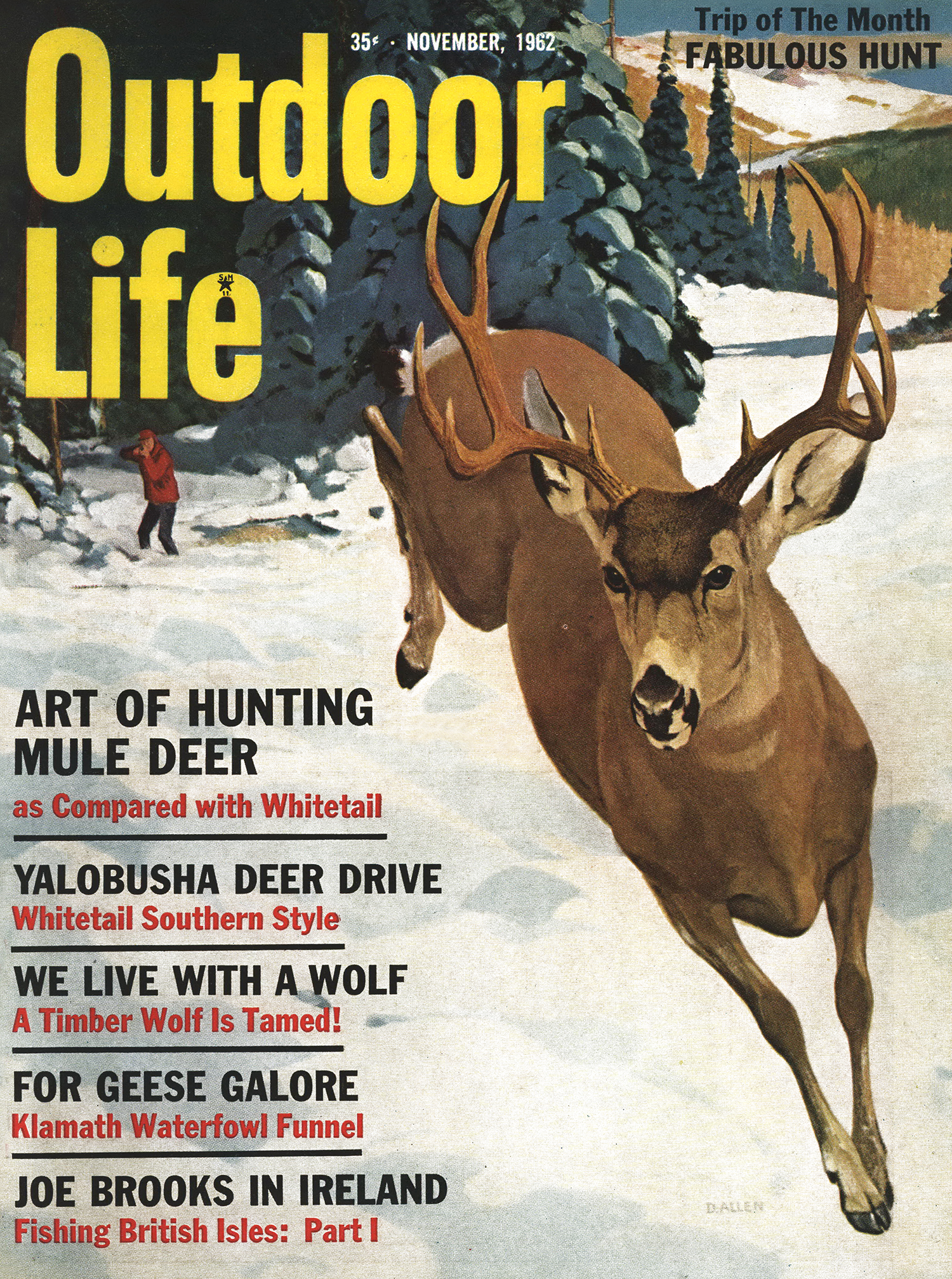
WHEN I FIRST moved to Indian River, the backroads were not snowplowed and we didn’t have a snow sled. Hunting in those days consisted of putting on snowshoes and taking to the woods with three or four dogs on leash, walking until we found a track and releasing our best cold-nosed hound. Then we followed him until the coyote was jumped, turned the rest loose, and kept going. Many days we walked 25 or 30 miles, many times we wound up at dark two townships away from our car, completely worn out and aching in every muscle.
I’m 47 now, however, and Roy is a year younger. The snow seems to be getting deeper each winter and the miles longer, and we find the sled a welcome help. The county road commissions do more snowplowing, too, and our hunting isn’t the rugged business it used to be. But we still count 10 to 15 miles on webs an easy day.
One morning about a month after the hunt that took us across Lake Michigan and back on the ice, Roy and I hit the fresh tracks of two coyotes crossing a swamp road a few miles south of Indian River. The early winter snow had settled, but there was about five inches of new fall on top. That meant good tracking. We had Roy’s younger brother Doyle along. He’d been with us a few times but had yet to kill his first coyote.
The three dogs we had with us that morning, Bruiser, Machine Gun, and Ring, are the most reliable cold-trailers in our pack. The tracks were so fresh that we decided to put all three down. They took off in a big circle, and we still had them in hearing when they jumped a couple of miles farther on.
Coyotes lie up at daylight, usually on a stump, log, or hummock. When two are traveling together, their beds are commonly 30 to 40 feet apart, as if each wanted to keep watch for himself. But during mating season they like to be together, and this pair was no exception. They had bedded side by side, but they separated in a hurry when they heard the dogs coming. Their tracks forked different ways into the swamp.
Dogs that jump a pair in breeding season often show a preference for running the male, but our hounds didn’t do that. The tracks were about the same size and we couldn’t tell at the time, but we found later that they went after the bitch.
They drove her hard for six miles and were out of hearing long before they ran her under a big windfall. There wasn’t room for any of the dogs to get all the way under, and when we got there she was taking on the pack one at a time. All three looked as if they’d stuck their heads in a meat grinder.
We couldn’t get a shot because of hounds dodging in and out, and finally Roy tried to hold them back while I went around behind the windfall, set my gun down, kicked off my webs, and dug away enough snow so that I could grab her by the hind legs.
I yanked her clear and heaved her 10 or 15 feet out into the open, all in one motion. She was about as mad as a coyote ever gets, but I’m still not sure whether she turned on me deliberately or was only trying to get back under the log jam.
Anyway, she whirled, made a couple of jumps through the snow, snarling like a buzz saw, and then launched herself straight for my throat, ears back, eyes blazing, mouth wide open. I couldn’t dodge and I threw up both hands to fend her off. She slashed at them, ripping away a glove and gashing my thumb. Then Machine Gun nailed her by the rear and Ring and Bruiser piled in behind him, and she had her hands too full to bother about me any more.
She fought her way back toward the windfall, growling and snapping. I got the trunk of a small tree between us, reached around it, and caught her by the tail. She twisted and lunged at me, but I hung on and kept the tree between us. Then Doyle came floundering up, breathing hard, sweat streaming down his face.
“Here’s your chance,” I yelled. “Hurry up and shoot her before she gets loose.”
He leveled his .30/06 but conditions were against him. I was trying to keep my hold on her tail, the dogs were swarming over her, and she was fighting all four of us. Doyle touched the gun off within three feet of her head but the shot blasted through her open mouth without even drawing blood. He bolted in another shell and put the muzzle of the rifle almost in her ear. The shock of the bullet telegraphed the length of her body. I actually felt the jolt of it in my wrists and arms.
WE WERE STILL talking things over when the dogs left and circled off in the direction the male coyote had gone. When a mating pair separates and the female is run, the male is very likely to stay off to one side and keep the chase within hearing. Other hunters have told us of males that even cut across the bitch’s track to lead the dogs off her. We’ve never seen that happen, but we’ve rarely known the male to get more than a mile away from his girl friend. We weren’t surprised when our hounds opened on a hot track 10 minutes after they left us.
Doyle offered to drag the dead coyote back to the road, pick up the jeep, and try to rejoin us later. Roy and I would follow the dogs.
We followed them a long time. The coyote lined out through swamps and rough country, running like a greyhound. The bawling of the dogs faded out almost as soon as they took the track, and that was the last we heard of them. We just walked, mile after mile. Wet snow started to pelt down, and we lost all sense of direction. Finally, we came over a ridge and saw Ring, Bruiser, and Machine Gun trotting back on the track to meet us. We knew what that meant. Somewhere up ahead they had killed the coyote.
We went on, and at the end of another hour we found the place where they had made the kill. They had cornered him at a deserted hunting camp and he had crawled under a tumble-down lean-to. They had carried the fight to him and he was dead.
“You know where we are?” I asked Roy. He shook his head. “That makes two of us,” I said.
HUNTING IN familiar territory, we don’t carry compasses, but that was one time we could have used one. We tied a dog leash to the coyote and struck out, dragging him. Darkness was only an hour away and it was snowing so hard we couldn’t see a city block ahead. We had eaten nothing since breakfast.
“It can’t be more than five or six miles to a road,” Roy said hopefully. “That depends on whether there are any roads the way we’re going,” I replied.
We slogged along through the storm with the dogs trotting behind, all the fire and fight gone out of them. The wet snow balled up on the fur of the coyote and he got heavier and heavier. Then it was dark. We debated stopping, building a fire, and waiting for morning, but when we checked our matches there wasn’t one dry enough to strike. We stumbled on, clawing through brush and tripping over logs. An hour after dark we came to an old logging road and recognized the remnants of a log bridge over a trout stream. We had walked west instead of east, as we thought, and were within a few miles of Walloon Lake, not far inland from Lake Michigan. We left the coyote there. We’d come back for him the next day. Two hours later we reached a plowed road and saw a light shining from the windows of a farmhouse.
The farmer’s wife fed us and our dogs, and when her two sons got home from town with the family car, long after midnight, they drove us back to Indian River.
We had traveled on snowshoes for 14 hours. I don’t know what our average speed was but certainly we had covered nearly 40 miles. Don’t let anybody try to tell us that coyote hunting, even in these days of snow-sleds and plowed roads, is soft stuff. Any time you want to separate the men from the boys just strap on a pair of snowshoes, turn three or four good dogs loose on a fresh track, and try to stay with them. Chasing brush wolves, the way we do it, isn’t for the faint of heart.
Read more OL+ stories.
